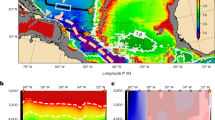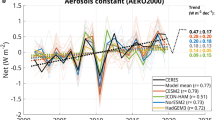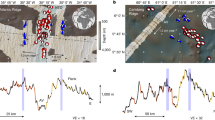Abstract
During the first half of the nineteenth century, several large tropical volcanic eruptions occurred within less than three decades. The global climate effects of the 1815 Tambora eruption have been investigated, but those of an eruption in 1808 or 1809 whose source is unknown and the eruptions in the 1820s and 1830s have received less attention. Here we analyse the effect of the sequence of eruptions in observations, global three-dimensional climate field reconstructions and coupled climate model simulations. All the eruptions were followed by substantial drops of summer temperature over the Northern Hemisphere land areas. In addition to the direct radiative effect, which lasts 2–3 years, the simulated ocean–atmosphere heat exchange sustained cooling for several years after these eruptions, which affected the slow components of the climate system. Africa was hit by two decades of drought, global monsoons weakened and the tracks of low-pressure systems over the North Atlantic moved south. The low temperatures and increased precipitation in Europe triggered the last phase of the advance of Alpine glaciers. Only after the 1850s did the transition into the period of anthropogenic warming start. We conclude that the end of the Little Ice Age was marked by the recovery from a sequence of volcanic eruptions, which makes it difficult to define a single pre-industrial baseline.
This is a preview of subscription content, access via your institution
Access options
Access Nature and 54 other Nature Portfolio journals
Get Nature+, our best-value online-access subscription
$29.99 / 30 days
cancel any time
Subscribe to this journal
Receive 12 print issues and online access
$259.00 per year
only $21.58 per issue
Buy this article
- Purchase on Springer Link
- Instant access to full article PDF
Prices may be subject to local taxes which are calculated during checkout





Similar content being viewed by others
Data availability
The palaeo-reanalysis is available from http://cera-www.dkrz.de/WDCC/ui/Compact.jsp?acronym=EKF400_v1.1 and instrumental temperature data from https://www.ncdc.noaa.gov/ghcnm/v3.php. The dryness indices for Africa are available from https://www1.ncdc.noaa.gov/pub/data/paleo/historical/africa/africa2001precip.txt and the Australian monsoon data from https://www.upo.es/vareclim/Data/Data_Index.php. The pressure data used are available from ISPD, https://reanalyses.org/observations/international-surface-pressure-databank. FUPSOL and HadCM3 model output can be downloaded from https://boris.unibe.ch/131129/.
Code availability
Code for the calculation of subtropical jet latitude and northern topical edge is from https://boris.unibe.ch/71204/. Code and input data for the reconstruction of Alpine summer temperature can be downloaded from https://boris.unibe.ch/131129/.
References
Zumbühl, H. J., Steiner, D. & Nussbaumer, S. U. 19th century glacier representations and fluctuations in the central and western European Alps: an interdisciplinary approach. Glob. Plan. Change 60, 42–57 (2008).
Leclercq, P. W. et al. A data set of worldwide glacier length fluctuations. Cryosphere 8, 659–672 (2014).
Miller, G. H. et al. Abrupt onset of the Little Ice Age triggered by volcanism and sustained by sea-ice/ocean feedbacks. Geophys. Res. Lett. 39, L02708 (2012).
PAGES 2k Consortium.Continental-scale temperature variability during the last two millennia. Nat. Geosci. 6, 339–346 (2013).
Masson-Delmotte, V. et al. in Climate Change 2013: The Physical Science Basis (eds Stocker, T. F. et al.) 383–464 (Cambridge Univ. Press, 2013).
Crowley, T. J., Obrochta, S. P. & Liu, J. Recent global temperature ‘plateau’ in the context of a new proxy reconstruction. Earth’s Future 2, 281–294 (2014).
Abram, N. J. et al. Early onset of industrial-era warming across the oceans and continents. Nature 536, 411–418 (2016).
Guevara-Murua, A., Williams, C. A., Hendy, E. J., Rust, A. C. & Cashman, K. V. Observations of a stratospheric aerosol veil from a tropical volcanic eruption in December 1808: is this the unknown ∼1809 eruption? Clim. Past 10, 1707–1722 (2014).
Garrison, C. S., Kilburn, C. R. J. & Edwards, S. J. The 1831 eruption of Babuyan Claro that never happened: has the source of one of the largest volcanic climate forcing events of the nineteenth century been misattributed? J. Appl. Volcanol. 7, 8 (2018).
Schurer, A., Tett, S. F. B. & Hegerl, G. C. Small influence of solar variability on climate over the last millennium. Nat. Geosci. 7, 104–108 (2014).
Schurer, A., Hegerl, G. C., Mann, M., Tett, S. F. B. & Phipps, S. Separating forced from chaotic variability over the last millennium. J. Clim. 26, 6954–6973 (2013).
Raible, C. C. et al. Tambora 1815 as a test case for high impact volcanic eruptions: Earth system effects. WIREs Clim. Change 7, 569–589 (2016).
Franke, J., Brönnimann, S., Bhend, J. & Brugnara, Y. A monthly global paleo-reanalysis of the atmosphere from 1600 to 2005 for studying past climatic variations. Sci. Data 4, 170076 (2017).
Lawrimore, J. H. et al. An overview of the global historical climatology network monthly mean temperature data set, version 3. J. Geophys. Res. 116, D19121 (2011).
Trachsel, M. et al. Multi-archive summer temperature reconstruction for the European Alps. Quat. Sci. Rev. 46, 66–79 (2012).
Nicholson, S. E., Dezfuli, A. K. & Klotter, D. A two-century precipitation dataset for the continent of Africa. Bull. Am. Meteorol. Soc. 93, 1219–1231 (2012).
Muthers, S. et al. The coupled atmosphere–chemistry–ocean model SOCOL-MPIOM. Geosci. Model Dev. 7, 2157–2179 (2014).
Sigl, M. et al. 19th century glacier retreat in the Alps preceded the emergence of industrial black carbon deposition on high-Alpine glaciers. Cryosphere 12, 3311–3331 (2018).
Lüthi, M. P. Little Ice Age climate reconstruction from ensemble reanalysis of Alpine glacier fluctuations. Cryosphere 8, 639–650 (2014).
Böhm, R. et al. The early instrumental warm bias: a solution for long central European temperatures series 1760–2007. Clim. Change 101, 41–67 (2010).
PAGES 2k Consortium. Consistent multi-decadal variability in global temperature reconstructions and simulations over the common era. Nat. Geosci. https://doi.org/10.1038/s41561-019-0400-0 (2019).
Hawkins, E. et al. Estimating changes in global temperature since the preindustrial period. Bull. Am. Meteorol. Soc. 98, 1841–1856 (2017).
Schurer, A. P., Mann, M. E., Hawkins, E., Tett, S. F. & Hegerl, G. C. Importance of the pre-industrial baseline for likelihood of exceeding Paris goals. Nat. Clim. Change 7, 563–567 (2017).
Iles, C. & Hegerl, G. C. The global precipitation response to volcanic eruptions in the CMIP5 models. Env. Res. Lett. 9, 104012 (2014).
Sontakke, N. A., Singh, N. & Singh, H. N. Instrumental period rainfall series of the Indian region (ad 1813–2005): revised reconstruction, update and analysis. Holocene 18, 1055–1066 (2008).
Gallego, D., García-Herrera, R., Peña-Ortiz, C. & Ribera, P. The steady enhancement of the Australian summer monsoon in the last 200 years. Sci. Rep. 7, 16166 (2017).
Hasselmann, K. Stochastic climate models part I. Theory. Tellus 28, 473–485 (1976).
Yu, Y. et al. Observed positive vegetation–rainfall feedbacks in the Sahel dominated by a moisture recycling mechanism. Nat. Commun. 8, 1873 (2017).
Held, I. M. et al. Probing the fast and slow components of global warming by returning abruptly to preindustrial forcing. J. Clim. 23, 2418–2427 (2010).
Gupta, M. & Marshall, J. The climate response to multiple volcanic eruptions mediated by ocean heat uptake: damping processes and accumulation potential. J. Clim. 31, 8669–8687 (2018).
Ding, Y. et al. Ocean response to volcanic eruptions in Coupled Model Intercomparison Project 5 simulations. J. Geophys. Res. Oceans 119, 5622–5637 (2014).
Stenchikov, G. et al. Volcanic signals in oceans. J. Geophys. Res. 114, D16104 (2009).
Gregory, J. M. et al. Climate models without preindustrial volcanic forcing underestimate historical ocean thermal expansion. Geophys. Res. Lett. 40, 1600–1604 (2013).
Church, J. A. et al. in Climate Change 2013: The Physical Science Basis (eds Stocker, T. F. et al.) 1137–1216 (Cambridge Univ. Press, 2013).
Maher, N., McGregor, S., England, M. H. & Sen Gupta, A. Effects of volcanism on tropical variability. Geophys. Res. Lett. 42, 6024–6033 (2015).
Mann, M. E. et al. Global signatures and dynamical origins of the Little Ice Age and medieval climate anomaly. Science 326, 1256–1260 (2009).
Franke, J., Frank, D., Raible, C. C., Esper, J. & Brönnimann, S. Spectral biases in tree-ring climate proxies. Nat. Clim. Change 3, 360–364 (2013).
Zumbühl, H. J., Nussbaumer, S. U., Holzhauser, H. & Wolf, R. Die Grindelwaldgletscher—Kunst und Wissenschaft (Haupt, 2016).
Nussbaumer, S. U., Zumbühl, H. J. & Steiner, D. Fluctuations of the Mer de Glace (Mont Blanc area, France) ad 1500–2050. Part I: the history of the Mer de Glace ad 1570–2003 according to pictorial and written documents. Z. Gletsch. Glazialgeol. 40, 5–140 (2007).
Nussbaumer, S. U. & Zumbühl, H. J. The Little Ice Age history of the Glacier des Bossons (Mont Blanc massif, France): a new high-resolution glacier length curve based on historical documents. Clim. Change 111, 301–334 (2012).
Küttel, M., Luterbacher, J. & Wanner, H. Multidecadal changes in winter circulation–climate relationship in Europe: frequency variations, within-type modifications, and long-term trends. Clim. Dyn. 36, 957–972 (2011).
Brönnimann, S. et al. Causes for increased flood frequency in central Europe in the 19th century. Clim. Past Discuss. https://doi.org/10.5194/cp-2019-17 (2019).
Wegmann, M. et al. Volcanic influence on European summer precipitation through monsoons: possible cause for ‘years without a summer’. J. Clim. 27, 3683–3691 (2014).
Alfaro-Sánchez, R. et al. Climatic and volcanic forcing of tropical belt northern boundary over the past 800 years. Nat. Geosci. 11, 933–938 (2018).
Gray, S. T., Graumlich, L. J., Betancourt, J. L. & Pederson, G. T. A tree-ring based reconstruction of the Atlantic Multidecadal Oscillation since 1567 ad. Geophys. Res. Lett. 31, L12205 (2004).
Martin, E. R. & Thorncroft, C. D. The impact of the AMO on the West African monsoon annual cycle. Q. J. R. Meteorol. Soc. 140, 31–46 (2014).
Krishnamurthy, L. & Krishnamurthy, V. Teleconnections of Indian monsoon rainfall with AMO and Atlantic tripole. Clim. Dyn. 46, 2269–2285 (2016).
Brönnimann, S. et al. Southward shift of the northern tropical belt from 1945 to 1980. Nat. Geosci. 8, 969–974 (2015).
Birkel, S. D., Mayewski, P. A., Maasch, K. A., Kurbatov, A. V. & Lyon, B. Evidence for a volcanic underpinning of the Atlantic Multidecadal Oscillation. npj Clim. Atmos. Sci. 1, 24 (2018).
Anet, J. G. et al. Impact of solar versus volcanic activity variations on tropospheric temperatures and precipitation during the Dalton Minimum. Clim. Past 10, 921–938 (2014).
Malik, A., Brönnimann, S. & Perona, P. Statistical link between external climate forcings and modes of ocean variability. Clim. Dyn. 50, 3649–3670 (2018).
Hegerl, G. C., Brönnimann, S., Schurer, A. & Cowan, T. The early 20th century warming: anomalies, causes, and consequences. WIREs Clim. Change 9, e522 (2018).
Brönnimann, S. Early twentieth-century warming. Nat. Geosci. 2, 735–736 (2009).
Braconnot, P. et al. Evaluation of climate models using palaeoclimatic data. Nat. Clim. Change 2, 417–424 (2012).
Shapiro, A. I. et al. A new approach to long-term reconstruction of the solar irradiance leads to large historical solar forcing. Astron. Astrophys. 529, A67 (2011).
Pope, V. D. et al. The impact of new physical parametrizations in the Hadley Centre climate model: HadAM3. Clim. Dyn. 16, 123–146 (2000).
Gordon, C. et al. The simulation of SST, sea ice extents and ocean heat transports in a version of the Hadley Centre coupled model without flux adjustments. Clim. Dyn. 16, 147–168 (2000).
Steinhilber, F., Beer, J. & Fröhlich, C. Total solar irradiance during the Holocene. Geophys. Res. Lett. 36, L19704 (2009).
Wang, Y.-M., Lean, J. L. & Sheeley, N. R. Modeling the Sun’s magnetic field and irradiance since 1713. Astrophys. J. 625, 522–538 (2005).
Crowley, T. J. & Unterman, M. B. Technical details concerning development of a 1200-yr proxy index for global volcanism. Earth Syst. Sci. Data 5, 187–197 (2013).
Smith, D. M. et al. Improved surface temperature prediction for the coming decade from a global climate model. Science 317, 796–799 (2007).
Martens, H. & Naes, T. Multivariate Calibration (Wiley, 1989).
Kruschke, J. Doing Bayesian Data Analysis. A Tutorial with R, JAGS, and Stan (Academic, 2014).
Brugnara, Y. et al. A collection of sub-daily pressure and temperature observations for the early instrumental period with a focus on the ‘year without a summer’ 1816. Clim. Past 11, 1027–1047 (2015).
Cram, T. A. et al. The international surface pressure databank version 2. Geosci. Data J. 2, 31–46 (2015).
Duchon, C. E. Lanczos filtering in one and two dimensions. J. Appl. Meteorol. 18, 1016–1022 (1979).
Compo, G. P. et al. The twentieth century reanalysis project. Q. J. R. Meteorol. Soc. 137, 1–28 (2011).
Acknowledgements
The work was supported by the Swiss National Science Foundation (projects 162668, 169676, CRSII2-147659 and a personal grant to M.T.), by MeteoSwiss (CH2018) and by H2020 (ERC Grant PALAEO-RA, 787574). Simulations were conducted at the Swiss Supercomputer Centre CSCS. G.C.H. and A.S. were supported by the ERC-funded project TITAN (EC-320691) and by NERC under the Belmont forum, grant PacMedy (NE/P006752/1).
Author information
Authors and Affiliations
Contributions
S.B. designed the study and performed most of the analyses. J.Franke performed the reanalysis. C.C.R. performed the FUPSOL model simulations and A.S. performed the HadCM3 model simulations. C.C.R., A.M., M.W. and A.S. processed the model simulations. M.T. performed the temperature reconstruction. J.Franke and J.Flückiger performed some of the analyses, S.U.N., D.S. and H.J.Z. analysed the glacier data. G.C.H. assisted the analysis and interpretation of the model data. All the authors engaged in the discussion of the results and contributed to writing the paper.
Corresponding author
Ethics declarations
Competing interests
The authors declare no competing interests.
Additional information
Publisher’s note: Springer Nature remains neutral with regard to jurisdictional claims in published maps and institutional affiliations.
Supplementary information
Supplementary Information
Supplementary Figures
Supplementary Table 1
Data behind Fig. 1
Supplementary Table 2
Data behind Fig. 3
Supplementary Table 3
Data behind Supplementary Fig. 1
Supplementary Table 4
Data behind Supplementary Fig. 2
Rights and permissions
About this article
Cite this article
Brönnimann, S., Franke, J., Nussbaumer, S.U. et al. Last phase of the Little Ice Age forced by volcanic eruptions. Nat. Geosci. 12, 650–656 (2019). https://doi.org/10.1038/s41561-019-0402-y
Received:
Accepted:
Published:
Issue Date:
DOI: https://doi.org/10.1038/s41561-019-0402-y
This article is cited by
-
The seasonal characteristics of English Channel storminess have changed since the 19th Century
Communications Earth & Environment (2024)
-
Braided motivations for Iceland’s first wave of mass emigration to North America after the 1875 Askja eruption
Regional Environmental Change (2024)
-
Impacts of major volcanic eruptions over the past two millennia on both global and Chinese climates: A review
Science China Earth Sciences (2024)
-
Impact of the Tambora volcanic eruption of 1815 on islands and relevance to future sunlight-blocking catastrophes
Scientific Reports (2023)
-
European tree-ring isotopes indicate unusual recent hydroclimate
Communications Earth & Environment (2023)



